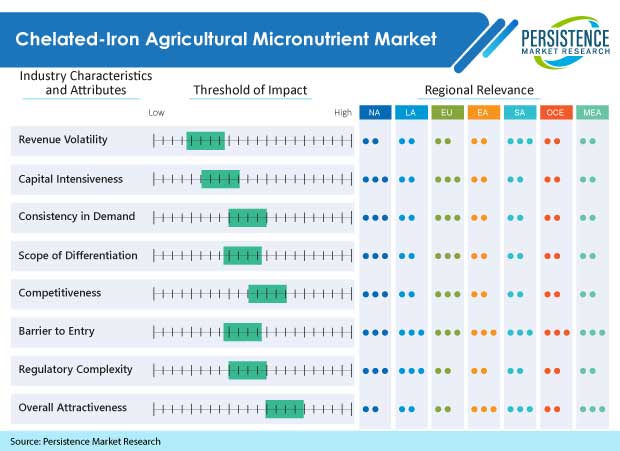Chelated-Iron Agricultural Micronutrient Market Segmented By Crop Micronutrients, Agricultural Chelates with Cereals, Pulses and Oilseeds, Fruits and Vegetables Crop Type
Industry: Food and Beverages
Published Date: September-2021
Format: PPT*, PDF, EXCEL
Delivery Timelines: Contact Sales
Number of Pages: 215
Report ID: PMRREP6337
Persistence Market Research has released a newly updated analysis on the chelated-iron agricultural micronutrient market landscape. In this study, analysts have estimated a market worth of nearly US$ 148 Mn in 2021, and have projected it to expand 2.7X by the end of the decade. The market is depicting an incremental opportunity of US$ 258.5 Mn by the end of 2031.
The global chelated-iron agricultural micronutrient market is expected to surge at a phenomenal CAGR of 10.6% over the next ten years.
Increasing influence of technology and making all tasks as efficient as they can get has been a major trend in the 21st century, and the agricultural sector is not untouched by it. Use of micronutrients in agriculture is not new but it has become more mainstream in recent times.
The benefits and value that micronutrients offer have been majorly realized by growers as well as manufacturers and distributors, and, as a result, use of micronutrients has escalated.
New nutrient delivery systems such as enzyme-micronutrient combination products that boost soil activity and nutrient uptake are entering the market, and they seem to have a positive outlook, along with other technology and advancements.
Balanced crop nutrition and soil health trends are growing as farmers tend to align their farming with sustainability goals. Companies such as WinField United and The Mosaic Co. are developing and researching products per this trend. Growing demand for quality nutrition is expected to be constant and the need for micronutrients is anticipated to grow over the coming years.

Chelated micronutrients are produced by altering positively charged cat-ions to negatively charged molecules.
As soil itself is negatively charged, it repels negatively charged molecules of chelated micronutrients, making it easily available for uptake by plants. Chelated-iron agricultural micronutrient is mostly used in calcareous (high pH) soils and soils low in organic matter.
High intensive farming and modern fertilizers have caused depletion of various micronutrients from the soil, which are essential for healthy plant growth.
Iron deficiency in plants causes chlorosis due to poor chlorophyll synthesis and also affects lignin formation, energy transfer and nitrogen reduction and fixation in plants.
The global chelated-iron agricultural micronutrient market is valued at US$ 148.6 Mn, and is set to register a CAGR of 10.6% from 2021 to 2031. The market is anticipated to attain a worth of approximately US$ 406 Mn by the end of the decade.
Asia Pacific (APAC) was the largest market for chelated-iron agricultural micronutrient with nearly 2/5 share of the overall market in 2020, followed by North America with approximately 1/4 of the market share.
Latin America is expected to exhibit highest CAGR during the forecast period, followed by MEA, which is expected to expand at a little lower CAGR. APAC is forecast to remain the most significant market, with highest absolute $ opportunity.
The world population is continuously increasing and the demand for quality food is increasing rapidly, especially in emerging markets as the purchasing power of buyers has grown significantly.
Upgraded farming practices and government subsidies to waive the fertilizers price for farmers have generated a good demand for chelated-iron agricultural micronutrient for crops like soybean, alfalfa and turf grass etc. Thus, the market for chelated-iron agricultural micronutrient is expected to exhibit a robust growth in the coming years.
Chelated micronutrients are produced by altering positively charged cat-ions to negatively charged molecules. Chelated-iron agricultural micronutrient is mostly used in calcareous (high pH) soils and soils low in organic matter.
High intensive farming and modern fertilizers have led to the depletion of various micronutrients from the soil, which are essential for healthy plant and crop growth.
| Attribute | Details |
|---|---|
|
By Crop Type |
|
|
By Region |
|
Key market players in the chelated-iron agricultural micronutrient market include Agrium Inc., Yara International Ltd., AkzoNobel, BASF SE, Monsanto Company, Bayer CropScience and DuPont.
To know more about delivery timeline for this report Contact Sales

Key players in the global chelated iron agricultural micronutrient that has been profiled in this report includes:
These players have been profiled on the basis of various attributes such as company overview, recent developments, growth strategies, sustainability and financial overview.
The U.S. and China are at the forefront in terms of export of chelated-iron agricultural micronutrients.
The chelated-iron agricultural micronutrient market expanded at a robust CAGR of 7.1% over the past five years
The chelated-iron agricultural micronutrient industry is currently worth approximately US$ 148 Mn.
The global industry is depicting an incremental opportunity of US$ 258 Mn by the end of the decade.
The market is expected to be guided by trends such as increasing fortifying products with micronutrients and government initiatives to promote agriculture.
In 2031, the chelated-iron agricultural micronutrient market is predicted to attain a net worth nearly US$ 406 Mn.
The market is expected to surge at an impressive CAGR of 10.6% over the decade.
Japan holds a market share of nearly 20% and South Korea holds a smaller share of 3.4%.
The need for effective fertilizers due to poor soil quality, ease of application, and effective functioning of the soil are major aspects controlling demand for chelated-iron agricultural micronutrients.
The U.S., China, U.K., and India are leading the demand for chelated-iron agricultural micronutrients.